
Recently on Cyclingnews.com |
 |
Test to destruction: The Keith Bontrager diary 2006
Keith Bontrager is best known as the bike and component design guru behind his eponymous road and mountain bike components, but behind the scenes the man universally known as KB is an enthusiastic and well-respected endurance mountain bike racer.
KB has taken part in a over 50 24-hour races in the last few years, and in his diary takes us inside the mental, physical and technical challenges of long-distance mountain bike racing while juggling the demands of an active interest in the successful international business he began all those years ago.
Portugal, July 19, 2006, Part 2, the bad and the ugly.
O Bom, O Mau, e O Feio (The Good, The Bad, and The Ugly)
Part 1 of this diary entry, The good, is here.
The Bad
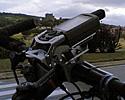
|
The sun was really the only bad part of the race (if you don't count the thorny berry bushes that were hanging over the course in spots), and that was all it took to turn it upside down for me. And, according to Antonio, it wasn't as hot as it can be, especially with an epic thunderstorm on one day and some overcast days around that.
Here's the way I explained it to an e-mail to a doc friend of mine:
"I am writing up my race report from Portugal for Cyclingnews.com now, and it's a tough one to get done. It's always easier to write about races that go well, but this one didn't."The first stage was long but I stayed at a comfortable pace and finished in eighth overall, in decent shape at the end. The stage was about 90 miles long, mostly off road, with 12000 feet of vertical (lots of small rolling hills, no monster alpine climbs).
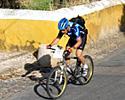
|
"But the temp on the day was in the mid 90s, up to 100 in spots. I drank 10 litres of water, ate a tonne, took salt and mineral supplements, all the things I have learned to do. I cramped a little in the last 30 km, and wasn't completely together at that point, but it was tolerable under the circumstances. I felt fine that night, rehydrated, ate and slept well.
"Then I came apart on the second stage. I'd ridden up the first climb OK, felt decent, not super but fine given the distance from the day before. I caught some of the riders in front of me. Then my legs went, and not long after that the rest of me went. It came on pretty suddenly. No power, nausea, I felt like shite, could not keep food or water down, and eventually started cramping.
"The latter is from dehydration (back of the hand skin pinch showed it) but there wasn't much I could do about it since drinking was such a problem. I laid in a small stream for five minutes to cool off and that helped for about three kilometres. I stopped a little while later.
"My amateur diagnosis is heat exhaustion.
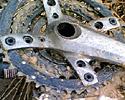
|
"I've been in this situation before and know what happens. I knew I wasn't acclimatised, so I tried to adjust my pace down. I thought that was working, but it wasn't. Once I popped, I knew it was gong wrong. Trying to go the last bit of a stage bonked, dehydrated, and cramping just to finish would have been possible, but pointless in this case, and counter productive. I've done that before. There was no reason to go that deep since this was for the miles and for the experience, building strength, etc for Canada - not for the results here at all costs.
"After this happened last time (South Africa) I decided I need to acclimatise to heat more thoroughly. The articles I found online about preparing for Athens talked about getting used to heat slowly, limiting exposure initially and building training duration and intensity for 21 days or more. That's what I had in mind for this race, but that plan went wrong when I ended up having to attend some sales events at dealers. There was nothing I could do about that. So I went to Portugal figuring it was possibly going to go wrong if it was hot, and it was, and it did.
"I did what I could to recover from the heat exhaustion on the stages after that, without quitting the race completely. I could ride at a decent pace for a while each day, until the same symptoms came on. Then I would melt down, but I stopped each time once I knew it was happening, or as close to that point as I could, in order to not dig a deeper hole.

|
"Eventually the weather turned cooler and I felt better, and magically I knew I could ride harder and finish stages. The first day that happened I was feeling good and I rode the first 70 km hard and felt fast. Then I hit a fence and landed on my head. My back and neck stiffened and I checked out a little after that.
"The next three days were pain killer assisted, but my legs came around and it was raining some of the time, so the temps dropped and I could go fast. I was as fit as I could to be, given the lack of racing I've been able to manage before the race this year. Most of what I'd done was long steady rides, and that was what was coming, so I felt pretty good about it. My results in some of the stages showed that things were fine in that respect too. There were times when I was riding with the leaders comfortably.
"I hate the heat."
Here is the doc's reply
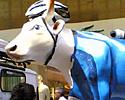
|
"With heat acclimatization, your body responds by increasing a hormone called aldosterone, produced by the adrenal glands, that help regulate salt balance. Your kidneys ultimately will retain more salt, increasing your total plasma volume. Your sweat glands adapt by decreasing the sodium secreted in sweat creating a more hypotonic sweat (thus conserving sodium). Your hypothalamus plays along by lowering the set point body temperature at which sweating will begin, so you begin to sweat sooner, and sweat more when you are acclimatised. So an acclimatised athlete needs MORE fluids than a non-acclimatised athlete for the same performance (distance, heat, effort, etc). Simply adding fluid to a non-acclimatised athlete will not help at all, so you need to acclimatise. Overall, when acclimatised, your body temperature will be lower for the same effort than when non-acclimatised."
If there is a lack of rigour here it isn't because she doesn't know, it's because I wouldn't understand the tighter explanation.
So there you have it. Acclimatise or die.
There are obvious differences between individuals and the articles I've read on the subject mention that. Julie is a perfect example - she lives in London. She is not properly acclimatised to heat in that environment, but she does not seem to need it. She rides very well in hot races But from an individual's perspective you either picked your parents well or you didn't, so you play the game with what you have.
I hope it isn't too hot in Canada next month…
I mentioned the other interesting and somewhat bad thing in that mail.

|
There were a series of gates we had to ride through on the fourth stage. The gates were rustic affairs, floppy things made from various types of wire strung together with posts and hung from the outermost posts that were part of fences. There were a few that were solid, hung on hinges, but not many. So you had to ride up to the gate, stop, fiddle with some wire and sticks to open it, let it fall to the ground, push your bike through the gap, then get off and stretch the gate back up and secure it. Some were very tight. In fact, Julie came to one she couldn't close, so she left it down and wrote a note on it explaining that she would have closed it but she wasn't strong enough (who rides with a pen and note pad and thinks to use them in a race?)
I caught Julie and Reg, one of the South Africans, at about 60 km and decided to ride with them and help with the gates, playing the domestique doorman role. That was going fine. I would open the gate, let them through, close it then ride back in front after the next gate. It made things easier. I did this with everyone else I was around on the course to make it fair too.
At one point I had some trouble with a gate and dropped back a little, so I was not in sight when Reg and Julie came to the next gate. Julie was worried about the goats making a break for it, so she closed it. Fair enough.
I was a minute or so behind, riding hard, trying to catch them. At the bottom of a little hill by a farm house I glanced over and saw them across the valley, not far ahead. The next thing I knew I was a metre away from a low wire gate that was closed, going way too fast to stop. Ouch. Luckily the wire was smooth, not barbed, and the landing zone was hard dirt, not rock. It could have been much worse.
Oh yeah, I did manage to ride off course pretty far one day. It was on a day when I started to feel good again, and there were some rollers, the kind you can stay in the big gear and go hard out of the saddle to avoid slowing down. I really like to ride those and started putting my head down a little, getting into it. At one point I remembered to look down at the GPS, and saw the arrow right where it was supposed to be, but no red line (the course). Whoops. I had to back track a little after that.
The Ugly
I flew to London and then on to Lisbon on British Airways. It was much cheaper than connecting with the Untied Airlines option. I booked it online.
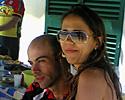
|
The flight from Heathrow to Lisbon was easy. There were some raised eyebrows at the amount of gear I had, but that is fairly normal. In fact, given the event, I had packed light. They didn't charge for the bike. Friends said that BA generally doesn't charge for bikes, so this fell into the pattern. Cool.
My baggage was lighter on the way back. I left some tires behind as gifts, etc, and didn't do any souvenir shopping. There was some mud and sweaty socks that added a little weight, but not that much. But as I was checking in at the airport in Lisbon there was a problem. I was told that I had to pay an excess baggage fee 700 euros! No way. This was about 10x higher than the cost per kg for flying a human! I know airlines are having a tough time, fuel is expensive, executives need their bonuses, etc. But this is a little out of line.
The pressure I brought to this was met with the usual good soldier approach - mindless obedience - these are the rules - what can I do, shrug. I checked on freight options and they are possible, and cheaper by far, but there wasn't enough time. They had me.
I usually fly United or American, and I pay an extra fee for my bicycle. No worries. I can understand that. But this was a little over the top, especially the way it had been done. You get there with no extra charges and then, on the way back when you have no options, they hit you with a bill that is close to the value of your bike!
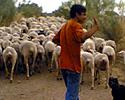
|
If you live in the UK or have to fly BA for some reason, I would reconsider. Actually I'd pay more to fly another airline. At the very least look very hard at the fees you might incur for your bike, or you might get ripped off.
The only other thing I can think of that was truly ugly recently was Materazzi's provocation of Zidane. If he said what was reported, and I believe Zidane's version of it so I think he did, Zidane should have aimed for his nose instead of his chest. It was a shame it came to that.
For a thumbnail gallery of these images, click here
Images by Keith Bontrager and friends
- Antonio prepping some tired bikes.
- A Pit Stop in Monsanto.
- Antonio's skills extend to emergency medicine.
- Chargrilled Sardines.
- Guess we're not in California anymore.
- Garmin GPS installed.
- Gustavo Bachi , enjoying having it over after a second place.
- How do you ride this technical bit?
- I think he was concerned about my health and offering to care for me.
- It wasn't always hot.
- Julie enjoying the view on the last stage.
- Liquid sunshine.
- Nuno Guerreiro finished in third place.
- Post race snacks.
- Ricardo Melo , the winner chilling at the end.
- Rolling into Sagres - Cal Burgart.
- Refuelling along the route.
- Stages.
- There were some distractions.
- The team is ready for the TdF.
- The locals were unfazed.
- Taking advantage of the shade.
- What Carbonstop brake pads come from.
- Winding it up at the start of stage 7 - Cal Burgart photo.
- Wonderfood.
